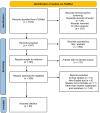The Impact of Stress and Depression on the Outcome of Human Gestation
- PMID: 38090445
- PMCID: PMC10715809
- DOI: 10.7759/cureus.48700
The Impact of Stress and Depression on the Outcome of Human Gestation
Abstract
Many researchers have reported on the high prevalence of anxiety and depression during pregnancy as well as the influence on delivery outcomes during the past decade. Preterm birth and premature labor, bleeding, higher frequency of cesarean section (CS), low birth weight, preeclampsia, stillbirth, miscarriage, NICU hospitalization, and a low Apgar score are the most commonly referenced outcomes assessed. Clarifying the relationship between exposure and result may help us to understand the risk factors and guide us to future clinical and research practices. The purpose of this narrative review is to search the following databases: PubMed, Research Gate, Scopus, Medline Plus, and present the most recent, comprehensive literature on the effects of stress and anxiety on pregnancy outcomes. Articles published from 01/01/2000 to 26/11/2022 were obtained from the previous databases. Anxiety and depression-related disorders are common nowadays, and they are frequently correlated with poor pregnancy outcomes. These problems are caused by a number of factors, including health social determinants, the individual obstetric situation, access to healthcare facilities, etc. The effects of each of these factors on birth outcomes range from major, such as preterm labor, congenital deformities, and low birth weight, to minor, such as mutations in the fetal epigenome. Both direct and indirect pathways of substantial interactions between depression, anxiety and stress, risk variables, and delivery problems were identified. Women's health practitioners and mental physicians must provide adequate support to these women in order to improve outcomes for both mothers and infants.
Keywords: antenatal anxiety; antenatal depression; antenatal stress; birth outcomes; birth weight; preterm birth.
Copyright © 2023, Arvanitidou et al.
Conflict of interest statement
The authors have declared that no competing interests exist.
Figures
References
-
- Prevalence and associated factors of antenatal depression: systematic reviews and meta-analyses. Yin X, Sun N, Jiang N, et al. https://doi.org/10.1016/j.cpr.2020.101932. Clin Psychol Rev. 2021;83:101932. - PubMed
-
- Maternal stress and obstetric and infant outcomes: epidemiological findings and neuroendocrine mechanisms. Austin MP, Leader L. Aust N Z J Obstet Gynaecol. 2000;40:331–337. - PubMed
-
- Prenatal maternal bereavement and mortality in the first decades of life: a nationwide cohort study from Denmark and Sweden. Yu Y, Cnattingius S, Olsen J, et al. Psychol Med. 2017;47:389–400. - PubMed
Publication types
LinkOut - more resources
Full Text Sources
Miscellaneous


